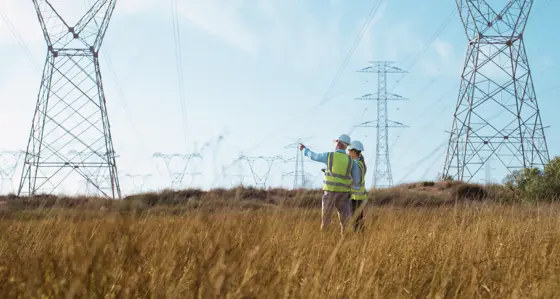
The Japanese Government’s energy policy reforms and focus infrastructure development offer substantial investment opportunities
6 min read 24 February 2024
Japan's energy market is undergoing an extensive transformation, aligned with the global move towards sustainable and renewable energy sources. Anchored by strategic initiatives such as its 6th Strategic Energy Plan (SEP) and the Green Transformation (GX) Act, Japan is ardently working towards its Net Zero commitment by 2050.
As the third-largest economy globally, Japan’s energy market reform and focus on infrastructure development have global significance and present substantial opportunities for investment. The Japanese Government envisions investments of over ¥150 trillion (US$996bn) over the next decade in both public and private funding.
Renewables are expected to comprise a large share of the generation mix including targets for up to 38% of solar, wind, geothermal, hydro and biomass by 2030 alone. This presents opportunities for solar, offshore wind, BESS (Battery Energy Storage Systems), hydrogen infrastructure, and the non-fossil value traded market.
Baringa’s Japan Reference Case provides an independent perspective on the demand and supply-side changes across Japan’s energy market, drawing on information from public sources as well as Baringa’s in-house views.
What’s driving Japan’s move towards a green economy?
Currently, more than 70% of Japan’s electricity is supplied via fossil-based thermal generation. With this, Japan’s electricity sector has been increasingly exposed to global commodity price fluctuations and energy price inflation. With limited domestic resources, Japan is heavily reliant on LNG and coal imports for its electricity generation.
As it seeks to decarbonise and achieve its Net Zero 2050 commitment, Japan has laid out a detailed strategy in the form of its 6th Strategic Energy Plan. The plan includes a 15% reduction of fossil fuel by 2030.
The Japanese Government is pushing for various regulation changes to achieve the targets set out in its SEP. The recent announcements of the Green Transformation (GX) Act and Hydrogen Basic Strategy, along with the implementation of carbon pricing for electric utilities by 2028, are some examples of this. In addition, the Japanese government is conducting renewable auctions for solar and offshore wind, extending nuclear plant life expectancies, and rolling out long term decarbonisation auctions.
Solar generation experienced 3900% growth in Japan in the past 11 years. So, what’s next for solar?
The introduction of the Feed-in-Tariffs (FiT) scheme in 2012 provided support for solar new-builds and resulted in an increase in solar generation from 1.8GW in 2011, to over 70GW by 2022. The scheme was replaced by the Feed-in-Premium (FiP) scheme in 2022.
Unlike FiTs which offer a fixed price 20-year contract, FiP payments are linked to the wholesale power market price and result in uncertain revenue streams. This encourages developers to utilise corporate PPAs together with FiPs to manage risks and exposures, and is particularly attractive for risk averse investors, or investors looking to secure debt financing. Alternatively, the introduction of FiP provides an avenue for investors who are willing to take on more risk to potentially secure higher revenues on the wholesale market, while being partially subsidised by FiP. Within the FiP framework, smaller scale, distributed solar resources under FiP with shorter development timeframes can be coupled with BESS, and aggregated into PPAs to offer better prospects amid soaring wholesale market prices and FiP rules that prevent FiP payment under certain conditions, given there is a rising demand from corporate buyers for green energy to meet immediate short term ESG commitments.
Increased offshore wind targets of 10GW of capacity by 2030, and between 30GW to 45GW by 2040
Japan’s Offshore Wind Promotion Act of 2019 lays the groundwork for ambitious targets of 10GW of capacity by 2030 and 30 to 45GW by 2040. The Act provides a structured framework for government-designated offshore wind "promotion zones", promising a stable investment environment with a 20-year FiP and a 30-year occupancy license, providing certainty for business operators.
Recent activity includes offshore wind auctions secured by consortia such as RWE, Mitsui and Osaka Gas, and Sumitomo and TEPCO Renewable Power, all reflecting growing momentum in this sector.
The Japanese Government has plans for further transmission infrastructure investment, including submarine HVDC lines, which are crucial to link generation capacity in remote areas with high-demand zones.
Japan’s Long-term Decarbonization Power Source Auction is set to encourage growth in BESS and create significant investment opportunities for energy storage solutions
BESS assets offer diverse revenue streams, participating in power markets such as JEPX, the capacity market, and balancing markets. The BESS market is expected to grow, driven by the need for grid stability amidst the renewable energy integration. Further, the government's new Long-term Decarbonization Power Source Auction provides opportunities for investment in energy storage solutions by offering a fixed 20-year payment on CAPEX costs.
Japan is set to become the world’s largest importer of hydrogen and ammonia as it seeks to decarbonize
The Long-term Decarbonization Power Source Auctions also include hydrogen and ammonia co-fired plants and the 20-year payments on CAPEX costs are a game-changer for hydrogen-based generation as it allows for existing units to tap on the scheme to achieve repowering.
In tandem, the country is laying a solid foundation for the introduction of hydrogen-based fuels in the generation mix, supported by measures such as a Contracts for Difference (CfD) subsidy to bridge the cost gap between low-carbon hydrogen and its fossil counterparts and encourage the adoption of clean hydrogen, aligning with Japan's decarbonization objectives.
Investors should keep up to date with Japan’s latest regulatory, policy and market developments
Investors will be watching ongoing market reform announcements. In addition, investors should also consider the following:
- For solar development it is crucial that investors thoroughly understand the FiP calculation rules and FiP payout behaviour before engaging in FiP auctions. This includes evaluating the benefits of combining FiP with PPAs to stabilise the revenue streams and increase PPA attractiveness to corporate offtakers. Further, investors should look to combining solar developments with BESS to unlock further revenue under FiP.
- For offshore wind, understanding the complexities of the FiP program's pricing dynamics and recent “zero premium” bidding behaviour will be essential to make informed bidding decisions. Appointing experienced bid advisors who can help you navigate through the complexities of the offshore wind auctions and secure a winning bid is recommended.
- For BESS developers who are risk averse, make use of the nascent LTDA auctions to secure 20-year capacity payments, while optimizing the remaining floating revenue portions to maximise revenues across the various power markets that BESS can participate in.
- For BESS developers who are looking for more upside in the merchant market, look towards obtaining robust wholesale power price projections, balancing market price projections and capacity market price projections to better develop your BESS trading algorithms to maximize BESS revenues.
- For hydrogen economy engagement, consider positioning investments to benefit from METI's long-term decarbonization power source auction system, taking advantage of the fixed and variable payment structure.
Japan's energy market is an attractive sector for investment aimed at long-term sustainability and profitability. The country's strategic direction, reinforced by legislative support and policy incentives, offers a clear roadmap for renewable energy investors.
Baringa has supported investors and developers across Asia-Pacific on numerous project financing transactions. We help our clients to identify which technologies to invest in, the locations with the most potential, and the optimum timing of entry.
Baringa’s Japan Flexibility Market Report offers an in-depth analysis of the BESS landscape in Japan. It covers the current state of BESS assets, the regulatory framework, available schemes for developers, and long-term projections of potential revenue streams across different power markets.
Find out more about the report and the risks and opportunities for investment, by contacting one of our experts below.
Our Experts


Related Insights

Synchronisation of the Baltic power system with Continental Europe opens exciting opportunities for batteries
The synchronisation of the Baltic power system with continental Europe is a significant milestone that opens exciting opportunities for batteries.
Read more
Renewables Market Scanning Report
Which are the most attractive markets for investing in renewable assets globally?
Read more
How can investors and developers capitalise on South Korea’s evolving energy market?
South Korea's energy market is transforming in line with the global shift to renewable energy.
Read more
How ‘Equipment-as-a-Service’ models unlock commercial decarbonisation
Read our latest piece, created in collaboration with Tallarna, to explore the components of an ‘Equipment-as-a-Service’ model, how they can be deployed, and how to increase take-up.
Read moreRelated Client Stories

Maximising impact from AI investment for a global energy leader
Discover how a series of experiential learning events resulted in employee confidence in AI skills hitting 85%.
Read more
Maintaining the stability of the New South Wales power system
How do you ensure the future stability of the NSW power system?
Read more
Using AI to manage applications for connecting low-carbon devices
With growing calls for processes to be standardised, Baringa and Energy Networks Association (ENA) came together to develop and launch the first central industry platform to transform the way registrations for low-carbon devices are managed.
Read more
Collaborating globally to future proof Australia’s water resources
How do you effectively manage the ever-evolving supply and demand challenges of water resources?
Read moreIs digital and AI delivering what your business needs?
Digital and AI can solve your toughest challenges and elevate your business performance. But success isn’t always straightforward. Where can you unlock opportunity? And what does it take to set the foundation for lasting success?